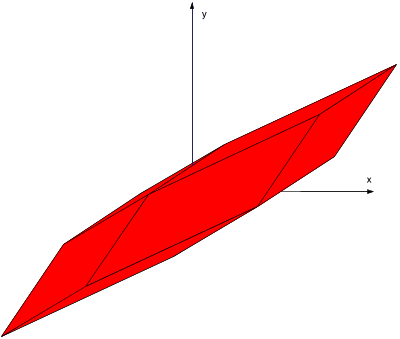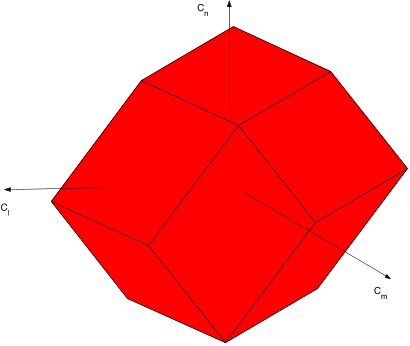
A Comparison of Two Methods Used to Deal with Saturation of
Multiple, Redundant Aircraft Control Effectors
Mark D. Nelson
Thesis submitted to the Faculty of the
Virginia Polytechnic Institute and State University
in partial fulfillment of the requirements for the degree of
Master of Science
in
Aerospace Engineering
Dr. Wayne Durham - chair
Dr. Frederick Lutze
Dr. Chris Hall
August 2001
Blacksburg, Virginia
Keywords: Control Allocation, Moment Direction Preservation, Moment Prioritization,
Control Saturation, Redundant Aircraft Controls
Copyright 2001, Mark D. Nelson

A Comparison of Two Methods Used to Deal with Saturation of
Multiple, Redundant Aircraft Control Effectors
Mark D. Nelson
(ABSTRACT)
A comparison of two methods to deal with allocating controls for unattainable moments
in an aircraft was performed using a testbed airframe that resembled an F/A-18 with a
large control effector suite. The method of preserving the desired moment direction to deal
with unattainable moments is currently used in a specific control allocator. A new method
of prioritizing the pitch axis is compared to the moment-direction preservation. Realtime
piloted simulations are completed to evaluate the characteristics and performance of these
methods.
A direct comparison between the method of preserving the moment direction by scaling the
control solution vector and prioritizing the pitching moment axis is performed for a specific
case. Representative maneuvers are flown with a highly unstable airframe to evaluate the
ability to achieve the specific task. Flight performance and pilot interpretation are used to
evaluate the two methods.
Pilot comments and performance results favored the method of pitch-axis prioritization.
This method provided favorable flight characteristics compared to the alternative method of
preserving the moment direction for the specific tasks detailed in this paper.

Acknowledgments
I would like to thank first and foremost my parents for their support and unending advice
that have helped me to make the most of myself and live my life to the fullest. To my sister
Julie and my brother Daniel with whom I have the fortune of knowing. Julie’s pursuit to
make the most of life in the face of constant hurdles, and Dan’s quest to never be in the
shadow of older siblings has made our relationships both exhaustive and rewarding.
I would like to thank my advisor Dr. Wayne Durham for his persistence and patience with me
and my academic career. He has given me the perfect work environment and has constantly
pushed me, with much resistance, to achieve all that I could. To the remaining members of
my commitee, Dr. Fred Lutze and Dr. Chris Hall, thank you for making my education at
Virginia Tech a wonderful experience and for sharing everyday life experiences with me.
I must thank my friends that have made my life at Virginia Tech so enjoyable. To Mike
Henry, Kevin Waclawicz, Dan Hart, Todd Norell, Trevor Wallace, Roger Beck, Josh Durham,
Bill Oetjens, and others that mean so much to me. To the friend that I lost, and the ones
that I have recently gained, I will always remem ber you. Finally, I would like to thank the
few friends back home who have offered me support from a long ways away and have never
lost touch.
iii

Contents
Abstract......................................... ii
Acknowledgments.................................... iii
TableofContents.................................... iv
ListofFigures...................................... v
ListofTables ...................................... vi
Nomenclature...................................... 1
1 Introduction 1
1.1 Background .................................... 1
1.2 AllocationProblem................................ 2
1.3 AllocationMethods................................ 3
1.4 AttainableMoments ............................... 5
1.5 ResearchObjectives................................ 7
2 Control Allocation 9
2.1 Introduction.................................... 9
2.2 Background .................................... 9
2.3 CascadingGeneralizedInverses ......................... 10
2.4 FacetSearch.................................... 10
iv

2.5 BisectingEdgeSearchingAlgorithm....................... 11
2.5.1 Two-DimensionalProblem........................ 12
2.5.2 Three-DimensionalProblem ....................... 13
3 Airframe Simulation and Implementation 16
3.1 Introduction.................................... 16
3.2 F/A-18Testbed.................................. 16
3.3 AirframeSimulation ............................... 20
3.3.1 Aero.f ................................... 20
3.3.2 Aeropa.f.................................. 20
3.3.3 Control.f.................................. 20
3.3.4 Constants.f ................................ 22
3.3.5 Engine.f .................................. 23
3.3.6 Alloc.f ................................... 23
3.4 SimulationEnvironment ............................. 23
3.5 AirframeValidity ................................. 23
4 Pitch Prioritization 25
4.1 Introduction.................................... 25
4.2 Sizing the Attainable Moment Subset . ..................... 25
4.3 MethodofPitchPrioritizationandMomentDirectionPreservation ..... 29
5 Represen tative maneuver 32
5.1 Background .................................... 32
5.2 Offset Carrier Approach maneuver . . ..................... 32
5.2.1 Offset Carrier Approach maneuver: Description . . .......... 33
v





